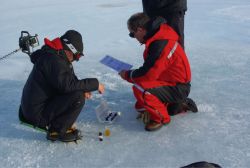Antarctica: What do scientists study at the Princess Elisabeth Station (Part 2) ?
Zorigto Namsaraev (BELDIVA) and Olivier Francis (GIANT) conduct experiments on the chemical composition of the water
© IPF / René Robert
Scientific studies continue at the Princess Elisabeth Station (PEA) in Antarctica, taking advantage of the summer months. Learn more about the GIANT-LISSA and the BELDIVA scientific teams' studies and find out what they discovered this year!
Like we mentioned in the first part of this article, the subjects studied by scientists in Antarctica are incredibly varied, as shown in the following paragraphs. Don't hesitate to click on the links in the text to see the field pictures, videos, interviews or complementary articles.
GIANT-LISSA is the code name for one of the projects now running at the Princess Elisabeth Station: "Geodesy for Ice in ANTarctica – Lithospheric and Intraplate Structure and Seismicity in Antarctica". This project aims to study the vertical deformations of the Earth’s crust around the station and the relation between ice mass variation and crust deformation.
You could wonder why it is important to conduct these field studies in Antarctica. Geodesy studies in Antarctica are important because, in the past, models were calibrated according to observations made in the Northern Hemisphere and do not really represent the Southern Hemisphere.
An ice sheet mass change has two distinct impacts on Earth’s crust: a short term response and a very long term response. This long term response is called the post-glacial isostatic rebound. This movement generally occurs in continents covered in ice, such as Greenland or Antarctica, and is caused by the variations in the mass of the ice cap that covers the continent. Such a quantity of ice is so heavy that it has consequences even for an entire continent: the continent will "float" lower into the underlying magma of the Earth mantle (the continental crust is depressed), just like a heavily loaded boat which will float lower into the sea. When the ice melts though, the continent will rise again, but its answer will last much longer than a boat's and it may take thousands of years for it to get back to its "equilibrated" level. For example, parts of Northern Europe are still rising at a rate of 1 cm/year as a response to the melting of the huge ice mass that was present in these parts during the last glacial period (last glacial maximum: 20,000 years ago).
As a consequence, in Antarctica, a vertical surface movement can be due either to the isostatic rebound related to the last deglaciation or to a recent ice mass change that can be an effect of global climate warming.
How do scientists measure those small vertical movements?
Two GPS (Global Positioning System) measure the vertical displacement of the Earth surface. Scientifics can’t however determinate how much of this displacement is due to the isostatic rebound and how much is due to recent ice mass changes. This is why this season the team installed a shelter specially built for absolute gravity (g) measurements. g depends on the distance to the Earth’s mass center and on the distribution of mass. A variation of g indicates thus a vertical movement of the Earth’s surface and/or a change in ice mass. They combine thus measurements from GPS with measurements of variations in gravity in order to determine if there are ice masse changes around the station.
The team has installed instruments which measure the seismic movements: either earth quakes or ice-related events. They can be distinguished because they produce signals of very different frequencies. Field trips may also help to study samples local rocks and mountains.
The "BELDIVA" is another running project which studies totally opposite subjects: tiny and organic. Indeed, the BELgian microbial DIVersity project in Antarctica studies microbes, microarthropods and lichens. The extreme climatic conditions in Antarctica do not allow higher plants to develop, except along the western Antarctic Peninsula where two species of flowering plants are found. Therefore, microorganisms dominate the surroundings of the Princess Elisabeth Station. They are not well-known. This project aims to study them and to observe possible future changes in their diversity due to ecosystem changes and human impacts.
The project has already been running for two years. Zorigto Namsaraev explains that there is quite a lot of life around the station, even though many thought there wasn't. There is life in the ice, in the rocks and even in the air. How can Bacteria live in the ice? When a dark particle lies on the ice surface, it absorbs more energy from the sun because it has a lower albedo than the ice. As a consequence, ice around it melts and a hole is formed, which is called a "cryoconite hole". When there is water, life develops This is one of the main subjects studied in this project.
This year, a few open-top plexiglass chambers will also be installed around the station: they protect small areas from the wind, allowing the temperature inside to rise a few degrees. This simulates the future temperature rise due to climate change and will allow scientists to see what impact this will have on the Bacteria.
During a field trip, the team even discovered two new lakes around the station! The surface of these lakes is frozen. Cyanobacteria (= blue-green Bacteria) are found in the sediments at the bottom of these lakes. They are especially adapted to (semi-)dark conditions – however surprising, there is enough light there for photosynthesis to take place.
To know more about the other scientific projects currently running at the Princess Elisabeth station, follow our next news on Educapoles. Meanwhile, you can take a look at the www.antarcticstation.org website for more images and videos.









